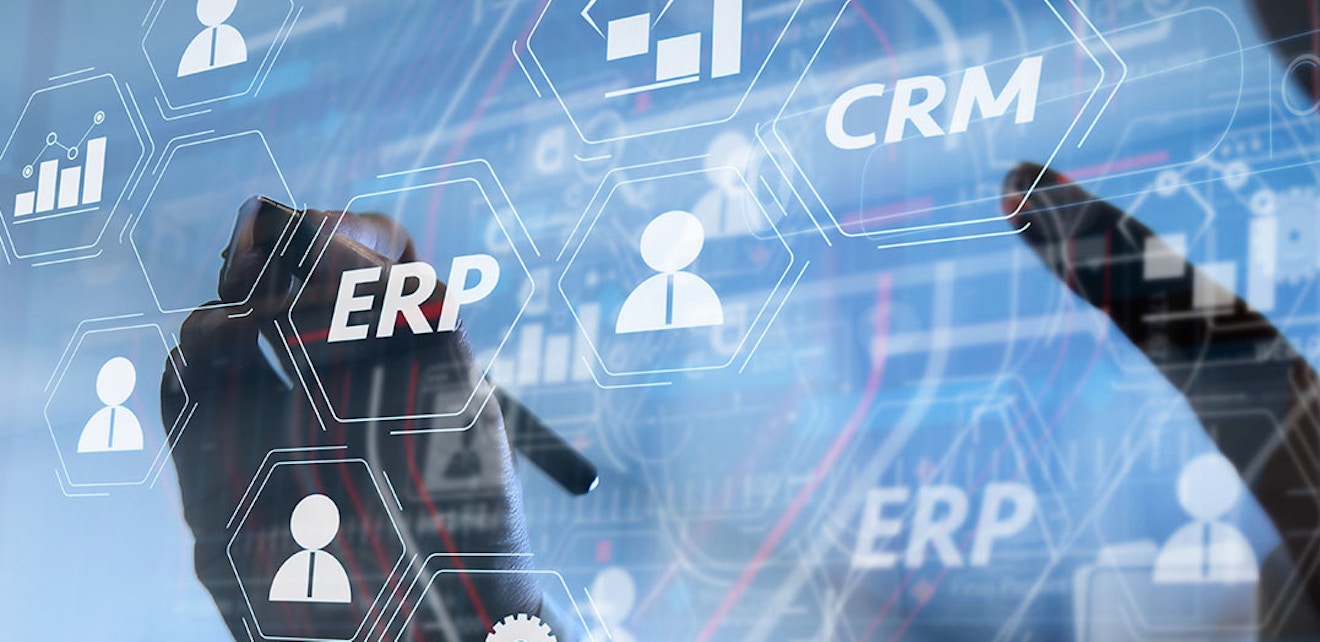Home > Blog
Read Time — 5 minutes
How ERP and CRM Systems Affect Your Business

For most businesses, ERP and CRM systems are an integral part of data management. These processes, although often used together, may function differently from business to business. In order to determine how these systems affect your business, it is important to distinguish their differences.
But, what exactly is the difference between ERP and CRM? In this article, we will discuss the systems and define the key advantages, disadvantages, and features of each. So, let’s dive right in.
What is ERP?
To put it simply, Enterprise Resource Planning (ERP) is a system that automates business processes and improves efficiency across all the departments of the organization. It supports both front and back-end business operations and reduces the redundancy of minuscule tasks.
ERP solutions can come in a few different shapes and sizes. The three main types of ERP solutions are on-premise, cloud, and hybrid. Now there are some pros and cons of each, so we will go into a little more detail.
On-Premise ERP
The first type of ERP that came into existence was an on-premise system. On-premise was the standard ERP solution in the 1990s considering that it was the first type of ERP system created. These systems are physically located on the business property with on-site implementation.
Since the ERP system is hosted on the business’s own computers or servers, they maintain complete control over its use and who has access to it. This can be beneficial for larger companies that need to share sensitive information internally, but some may say this is an outdated solution.
However, on-premise systems can not be used anywhere else besides the location it resides. Also, they can also be costly in the long run because upgrades have to be manually implemented. Without an experienced IT team, the necessity for on-site maintenance can be expensive and time-consuming.
Cloud-Based ERP
In the late 1990s, cloud-based systems were introduced to remedy the problems with on-premise solutions. As a SaaS (software as a system) solution, cloud-based ERPs are more flexible. They usually come in the form of a subscription from a software provider that can be upgraded depending on your business needs.
Since the system is web-based, the system relies on a secure Internet connection which can vary from location to location. But, this also means that you can get whatever information you need from the system just by having Internet access.
The service provider will most likely offer customer service and technical support to ensure that your processes run smoothly no matter where you are. Also, cloud-based ERPs protect your business data with a higher level of security at the most cost-effective price.
Hybrid ERP
Hybrid ERP systems are exactly what they sound like. They combine features from both on-premise and cloud-based ERPs for businesses looking for the reliability of the on-premise with the flexibility of the cloud-based system.
Since hybrid ERPs fuse the features of cloud-based and on-premise systems, they will typically be the more expensive option after on-premise systems. Similar to on-premise systems, you might still accumulate future costs for the maintenance of the system located on your property.
So, now that we can differentiate between the types of systems, let’s explore the features that most ERP solutions will offer.
The Key Features of ERP Systems
When implemented, ERP solutions can improve efficiency across the board in every department of your business. They automate the day-to-day processes and reports, so you and your employees waste less time working on redundant tasks.
Because ERP systems cover a lot of ground, there are many beneficial features that they offer, including…
- Financial management
- Supply chain management
- Production management
- Order processing
- Tracking and visibility
- Data analysis
- Reporting capabilities
- Accounting
- Sales management
- Customer Relationship Management (CRM)
As you can see, ERP systems cover a lot of ground and easily streamline these processes in one solution. Although most ERPs include these features, it’s important to note that CRM capabilities differ in a few key areas, such as contact management and sales activity management. So, now let’s discuss CRM more in-depth.
What is CRM?
While ERP systems gather data on internal processes and the entire business cycle, CRMs are specifically designed to manage data related to the business’s interactions with customers. Most ERPs will have a CRM component, but CRMs focus on the front-end operations of the business.
These systems can create sales forecasts, nurture prospective customers through the sales funnel, improve communication, and more. Similar to ERP, CRM improves the efficiency of these processes to ensure that the customer interactions are fruitful.
The overall goal of the CRM is to enhance the interactions between prospective customers and your organization. Moreover, you want the relationship to result in a sale to a customer who will remain loyal to your business.
The Key Features of CRM
Because CRMs are centered around your business’s external relationships, it is important to identify the features that will enhance the experience of your customers. Here are some key features that CRMs offer…
- Identify new leads
- Automate repetitive tasks
- Analyze purchasing patterns
- Automate marketing campaigns
- Streamline sales processes
- Provide high-quality customer service
Now that we know the differences between ERP vs CRM systems, let’s discuss the benefits of using them together.
How Both CRM and ERP Can Improve Your Business
As mentioned above, most ERPs will have some CRM capabilities included. These systems can connect to one database that streamlines all of your business operations. When you have an ERP that can integrate or sync with your CRM, you get the best of both worlds.
Some of the benefits of having both ERP and CRM integrated into your business include improved data accuracy, customer visibility, employee collaboration, and streamlined sales processes. So, you can drive sales and improve processes all while reducing your overall costs. What more could you ask for?
Get the Most Out of Your Systems With Khameleon
If you’re wondering how to enhance your day-to-day operations with an ERP that can integrate with your CRM, then consider a cloud-based solution with Khameleon.
For example, Khameleon integrates Hubspot, a CRM, into its solution by syncing data from customers, contacts, and projects. Plus, Khameleon’s ERP solution ensures the integrity of your data, so you can rest easy knowing that your business is in good hands.


